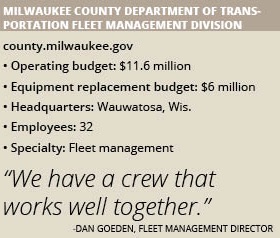Milwaukee County Department of Transportation Fleet Management Division
The Milwaukee County Department of Transportation’s Fleet Management Division ensures that the county’s vehicle and equipment needs are met.
By Jim Harris
The Milwaukee County Department of Transportation’s Fleet Management Division believes in working hand-in-hand with the end-users of the vehicles and equipment it supplies and maintains.
“The way we support our user departments sets us apart,” Fleet Management Director Dan Goeden says. “We make sure our assets are available and repaired in a fast and timely manner so our users can receive the best service at the lowest cost.”
With 19 communities and a combined population of more than 950,000 people, Milwaukee County is Wisconsin’s most populous county. The fleet management division supplies and maintains vehicles and equipment for county departments including the sheriff’s office, medical examiner, county zoo and park system and the highway department.
The division is responsible for more than 2,200 pieces of equipment, with roughly half of the fleet consisting of cars, trucks and other vehicles. The remainder of the fleet includes plows, trailers and road-salting rigs. The fleet supports the highway department who is responsible for salting, maintaining and patrolling roughly 2,200 total lane miles of freeway and country truck roads.
Since becoming director of the division in 2009, Goeden has met regularly with user departments to determine their ongoing equipment needs. “We discuss the equipment they have, and whether it functions the way they need,” he says.
Goeden and county department heads plan much of the department’s equipment needs before the division’s budget is drafted in June. “We want to procure equipment that is useable year-round as much as possible instead of just buying seasonal equipment,” he adds. “We tell our departments what their budget is, and what vehicles are on the replacement list for that year, and if the equipment they have on hand still works for them.”
Since starting the replacement program in 2009, the county has reduced its fleet by more than 200 vehicles. “We have a policy that if a vehicle is underutilized, we will work on getting a pool vehicle for that purpose,” Goeden says, noting this includes vehicles with 6,000 miles or less of annual use. “We want to reduce the amount of those vehicles and right-size our fleet. It’s nice to have extra pieces of equipment, but those cost money, so it really isn’t worth it to have those sitting around doing nothing.”
Replacement Needs
In 2015, the division entered the first year of a 12-year fleet replacement program. The program entails replacing sheriff’s squad cars every four years, sedans and pickups every seven years and large equipment such as plow trucks, front end loaders, bucket trucks and large lawn mowing equipment every 12 years.
Vehicles and other equipment are scheduled for equipment on a staggered basis. Equipment purchases are prioritized based on need. “We were pretty lucky in that we were fully funded our first year, but for this year we had a $1.8 million budget cut,” Goeden says. “We have taken pieces of equipment that would have been replaced this year and moved them out to another year, but let departments know if something is needed urgently, we will try to work with them for an alternative solution.”
The division purchases many of its new trucks from local vendors. Badger Truck Center of Milwaukee is one of our local vendors, which assembles its hydraulics and snow plows on the chassis. “They’re a local company, and we are happy with the service they provide,” Goeden adds. “They have available parts we need, and are professional to work with.”
Milwaukee County participates in the Wisconsin Smart Fleet program, which aims to reduce vehicle emissions. In addition to replacing existing equipment with hybrid or alternative fueled vehicles, the division has also instituted a five-minute shutdown policy on diesel trucks.
Staff Loyalty
Milwaukee County’s fleet was recently recognized as one of the top 100 fleets in North America by The 100 Best Fleets competition. The competition recognizes fleet management teams based on criteria including accountability, collaboration, creativity, efficiency, staff development and culture.
“We have a crew that works well together,” Goeden says. “Some of our people have been with us for a long time; we have good loyalty here.”
The fleet management department builds that loyalty in part by involving staff members in budget and other decisions. “I’m proud of the amount of work we’re able to do with a limited staff,” he adds, noting the division employs 19 mechanics and 32 total people. “I think that, for the size of staff we have compared to the amount of equipment that we handle, it’s phenomenal what our guys are able to accomplish.”